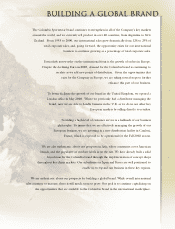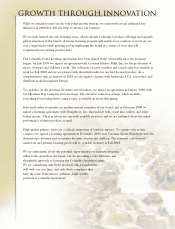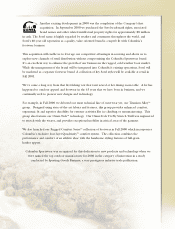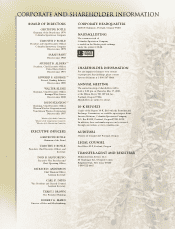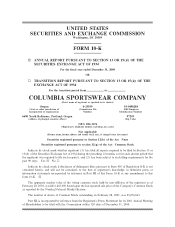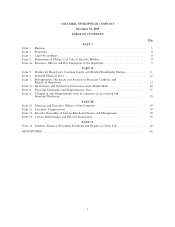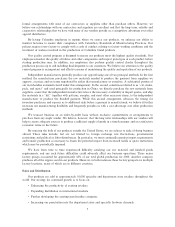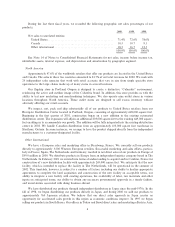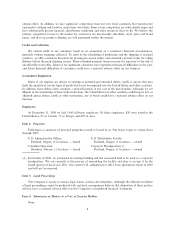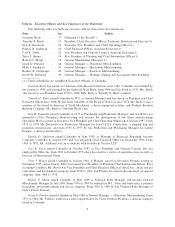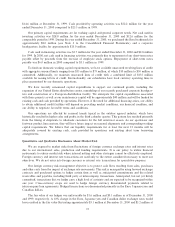Columbia Sportswear 2000 Annual Report Download - page 17
Download and view the complete annual report
Please find page 17 of the 2000 Columbia Sportswear annual report below. You can navigate through the pages in the report by either clicking on the pages listed below, or by using the keyword search tool below to find specific information within the annual report.formal arrangements with most of our contractors or suppliers other than purchase orders. However, we
believe our relationships with our contractors and suppliers are excellent and that the long-term, reliable and
cooperative relationships that we have with many of our vendors provide us a competitive advantage over other
apparel distributors.
By having Columbia employees in regions where we source our products, we enhance our ability to
monitor factories to ensure their compliance with Columbia's Standards of Manufacturing Practices. Our
policies require every factory to comply with a code of conduct relating to factory working conditions and the
treatment of workers involved in the production of Columbia brand products.
Our quality control program is designed to ensure our products meet the highest quality standards. Our
employees monitor the quality of fabrics and other components and inspect prototypes of each product before
starting production runs. In addition, our employees also perform quality control checks throughout the
production process up to and including Ñnal shipment to our customers. We believe our attention to the quality
control program is an important and eÅective means of maintaining the quality and reputation of our products.
Independent manufacturers generally produce our apparel using one of two principal methods. In the Ñrst
method, the manufacturer purchases the raw materials needed to produce the garment from suppliers we
approve, at prices and on terms negotiated by either that manufacturer or ourselves. A substantial portion of
our merchandise is manufactured under this arrangement. In the second, sometimes referred to as ""cut, make,
pack, and quota'' and used principally for production in China, we directly purchase the raw materials from
suppliers, assure that the independent manufacturers have the necessary availability of import quotas, and ship
the materials in a ""kit,'' together with patterns, samples, and most other necessary items, to the independent
manufacturer to produce the Ñnished garment. While this second arrangement advances the timing for
inventory purchases and exposes us to additional risks before a garment is manufactured, we believe it further
increases our manufacturing Öexibility and frequently provides us with a cost advantage over other production
methods.
We transact business on an order-by-order basis without exclusive commitments or arrangements to
purchase from any single vendor. We believe, however, that the long term relationships with our vendors will
help to assure adequate sources to produce a suÇcient supply of goods in a timely manner and on satisfactory
economic terms in the future.
By sourcing the bulk of our products outside the United States, we are subject to risks of doing business
abroad. These risks include, but are not limited to, foreign exchange rate Öuctuations, governmental
restrictions and political or labor disturbances. In particular, we must continually monitor import requirements
and transfer production as necessary to lessen the potential impact from increased tariÅs or quota restrictions
which may be periodically imposed.
We have from time to time experienced diÇculty satisfying our raw material and Ñnished goods
requirements, and any such future diÇculties could adversely aÅect our business operations. Three major
factory groups accounted for approximately 18% of our total global production for 2000. Another company
produces all of the zippers used in our products. However, in both instances these factory groups have multiple
factory locations, many of which are in diÅerent countries.
Sales and Distribution
Our products are sold to approximately 10,000 specialty and department store retailers throughout the
world. Our strategy for continued growth is to focus on:
‚ Enhancing the productivity of existing retailers
‚ Expanding distribution in international markets
‚ Further developing the existing merchandise categories
‚ Increasing our penetration into the department store and specialty footwear channels.
5


